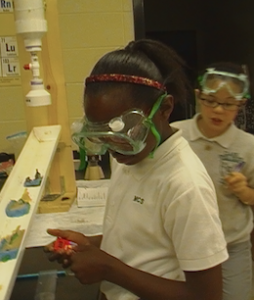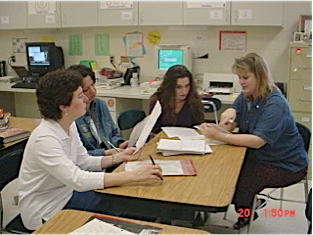7 Valuable Roles for STEM Teacher Leaders
A MiddleWeb Blog

In the STEM education arena, teacher leaders are particularly crucial. All STEM teachers can be classroom leaders, but every school and district needs to invest time and resources into developing STEM Teacher Leaders (STLs – an acronym I just concocted) to take on additional roles and responsibilities.
In many schools and districts, educators who fit my definition of “STL” are already playing a central role in improving STEM programming and supporting fellow teachers outside of their own classrooms.
These teacher leaders often have more credibility with their peers than educators who are no longer in the classroom (that would include me). They’re extremely useful; maybe even indispensable.
What might you be doing if you were a STEM Teacher Leader? Exactly what roles and responsibilities might you fulfill? Here are a few ideas to chew on.
1. STLs can be involved in policy and advocacy
Let’s start at the state and district levels. As an STL you might advocate for policy changes that would create a more productive STEM teaching environment.
For example, overcrowded conditions when kids work with equipment in laboratories or classrooms create an unsafe learning environment and decrease the teacher’s ability to provide quality learning experiences. The recommended number of students for a science laboratory is 24, and that number would be true for STEM projects as well.

As a STEM Teacher Leader you might also build a network of STEM teachers. This is a terrific way to share best practices and make recommendations to policymakers.
This network might include online features such as a Facebook group, a network on social media like Bluesky, perhaps a regular video gatherings among STEM colleagues at Google Meet . (I would involve a technology teaching colleague to help me with that kind of task.)
Also, how about arranging for face-to-face meetings of STEM educators – perhaps at a science, math, or technology mini-conference organized by teachers for teachers?
2. STLs help in STEM planning & decision-making.

As an added benefit of being involved in STEM planning, these STLs would make good salespersons and advocates for moving the vision forward and gaining buy-in from fellow teachers and community people who listen to teachers.
3. STLs facilitate professional learning for colleagues
This could happen in a variety of ways. As an STEM Teacher Leader you could . . .
- Facilitate teacher learning teams. In these teams, small groups of teachers meet regularly and work together to continually improve their teaching. STEM teachers focus directly on STEM instructional skills, share their work, motivate one another, and hold each other accountable. For some ideas to help set up and facilitate teacher teams, you might take a look at my book Team to Teach: A Facilitator’s Guide to Professional Learning Teams. (If you’re interested, I recommend getting used copies here!)
- Be a STEM instructional coach. Provide resources and work individually with classroom teachers when possible to help them with STEM instructional strategies and inquiry-based teaching approaches. Be available to observe and provide constructive feedback.
- Mentor novice STEM teachers. Commit yourself to help new STEM teachers unlock a lifelong passion for science and engineering.
4. STLs can find funding for programs & equipment
Dust off your grant-writing pen and get busy locating grant opportunities. (Type “STEM grants for teachers” into a search engine for help with that.) For example, as teachers guide kids through STEM projects, they will undoubtedly come up with awesome ideas and creative approaches. You might use those discoveries to write a proposal for funding to further develop those ideas and create successful models to support student learning.
Approach business and industry in your area for funding as well. They can often help with equipment and supplies and even some training for teachers.
5. STLs can help all students receive a first-rate STEM education

6. STLs can keep STEM programs on the front burner
Involving parents is a great way to do this. You might hold a session to educate parents about STEM. STLs can also encourage teachers to use parents and community members to monitor the classroom during STEM projects – especially those that involve a lot of equipment.
You can also get the word about students’ STEM accomplishments out to the community and publicize what problems they’re solving in their STEM challenges. Above all, be sure to lead in celebrating successes.
Soon the “next new thing” in education will be coming down the pike, and the focus will shift away from STEM. Safeguard the needs of students by continually working to ensure that STEM practices remain at the center of what is done in the classroom and in policy making.
7. STLs can model continuous professional learning

STLs need a deep understanding of key concepts, skills, and reasoning methods of middle school mathematics and the sciences. They need experience with the engineering design process. They must understand project-based learning strategies and inquiry-based instruction.
STLs also need facilitation skills for working successfully with teacher teams and individual teachers, parents, and others. I’ve created a tool with tips that can be helpful to all of us who find ourselves in STEM teacher leadership roles. Feel free to download it and use any ideas that appeal to you.
Tips for Building Strong Relationships
with STEM Colleagues
STEM needs teacher leaders!
STEM Teacher Leaders do not have to do all the things mentioned in this post – or any of them for that matter. Whether you find yourself in an official role or taking on STEM teacher leadership as a personal project, your work as a STL might take another direction entirely.
But in the final analysis, the work of a STL at the state, district, and local levels should foster the attitude that student success in life may hinge on the kind of teaching and learning that goes on in STEM classrooms.


































Anne, I am impressed with what you are actually doing to promote STEM learning. I am Bhoj Raj Rai, Chief of Science and Maths Division at the Royal Education Council in Bhutan and we develop national curriculum. I would be glad if you could help us establish these STEM subjects in our school curriculum. We can collaborate and discuss further on this.